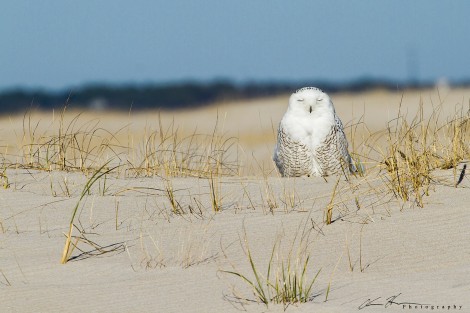
Snowy Owl on the Eastern Shore. Photo: Chris Hudson
CARRIE SAMIS | 21 December 2013
Okay, try to stay with me. I’m sooo excited about all of this, that it might be difficult to keep up!
This is perhaps the most exciting confluence of people, places, popular culture, placement & purpose, ever, for me, here on Delmarva. Seriously. I can’t type fast enough. So soooo many connections to be excited about. Connections with communities & conservation. I LOVE IT. It’s social, it’s science… and it’s snowballing… and it’s the most wonderful time of the year!
So, here’s the quick rundown in enthusiastic and, hopefully, easily-digestible bits:
Snowy owls are big, beautiful, charismatic birds. They live in the arctic. Birders love them. Non-birders love them. How can you not think a snowy owl is awesome?! And now, thanks to Harry Potter, even young kids know about them, as the young wizard’s snowy owl, Hedwig, is a book character, a movie star, and is available as a plush toy.
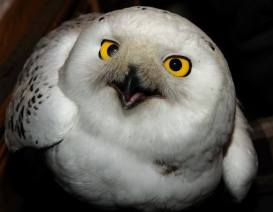
This year, an unusual number of snowy owls are showing up in the US. They have been seen along our coasts, in farm fields, at airports, and in neighborhoods. Snowies have been spotted as far south as South Carolina. Regular sitings are occurring in the Delmarva area, with more than a dozen birds spotted in Delaware, Maryland, and Virginia. E-bird, an online resource for birders and scientists, has an up-to-date map of where birds are being seen.
As expected, birders and photographers are clamoring to see the birds. But guess what? Because these are such charismatic birds, lots of people are excited about catching a glimpse of this visitor from the arctic. Yes, the “general public” is interested. You may have seen articles in your local newspapers, posts online, and television segments with stories about snowy owls. My 6-year old daughter Ella saw her first 2 snowy owls at the same time, both sitting on a sand dune at Delaware Seashore State Park. Dozens of people were tickled to get great looks at the birds over Thanksgiving weekend.
Here’s the newest bit of snowy news – Project SNOWstorm. Researchers David Brinker and Scott Weidensaul recognized this season’s snowy owl irruption as a unique opportunity to learn more about the birds and provide opportunities for people like me – and YOU – to be involved.
Together with other field scientists, including Norm Smith in Massachusetts, Jean-Francois Therrien in Pennsylvania, and Eugene Jacobs in Wisconsin, Brinker and Weidensaul are fitting snowy owls with transmitters made by Mike Lanzone at Cellular Tracking Technologies. These transmitters will allow researchers the opportunity to track the movement of the birds. And here’s one of the most exciting bits: the FIRST bird to be fitted with a transmitter for the project, was a bird on Assateague Island! On Tuesday, December 17th, the bird was captured at Assateague using a bow net. The bird was a healthy, hatch-year male. Scientific measurements were taken, including weight, tail length, and wing chord, and the bird was fitted with a 1050A transmitter manufactured by Cellular Tracking Technologies. The solar-powered transmitter weighs approximately 40 grams which, per scientific protocol, is less than 3% of the bird’s body weight. Ocean City photographer Allen Sklar, who happened to be in the right place at the right time, was lucky to have the chance to photograph the process.
Currently, Project SNOWstorm has 5 additional transmitters to put on snowy owls but, with additional funding, that number could increase. It can cost up to $3,500 to fit a bird with a transmitter. Utilizing Indiegogo, an international crowdfunding site, a fundraising campaign for Project SNOWstorm will launch after the New Year. I’ll be sure to keep you updated when that happens!
What else can we expect from Project SNOWstorm?
Together, the growing team will coordinate efforts to collect data from rehabbers throughout the US when sick or injured birds show up. Additional data may also be collected, including blood samples which can help researchers assess the health status of the birds. Sexing and identifying individual birds by color patterns will increasingly improve as more birds are documented. If you see a snowy owl, and are able to get good photographs of wing and tail patterns, you’ll be able to submit those photographs to the project, online. The Project SNOWstorm website should be up in the early part of the year. Remember, I mentioned the snowball effect of snowy owls and the project… people are excited and enthusiastic… researchers are in the field fitting birds with transmitters (no easy task!)… and, simultaneously, folks are working hard to set up the Indiegogo fundraising site and the Project SNOWstorm website. Oh, and it’s Christmastime – so, we’ll all be spending cherished time with our family and friends. So, hang tight!!! It’s anticipated that, in January and February, there will be plenty of opportunities to get outside, to see birds, to photograph them, to contribute financial support, and to get involved in the project in some way. In the meantime, you might want to review the ABA Code of Ethics. It’s important to be sure we’re respecting the birds and each other when we’re outside.
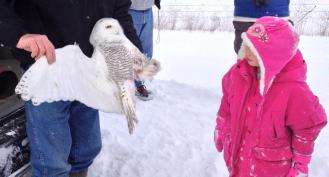
A snowy owl banded in Wisconsin, just prior to Christmas 2013. Photo: Inga Parker La Puma
It’s true, during this snowy owl irruption, some birds may die. Typically, 60-70% of first year birds die, no matter the species. That’s how nature works. Rest assured, only healthy snowy owls are being outfitted with the transmitters. What threats do these birds face? One of the threats that snowies face is collision. These arctic residents don’t typically navigate areas populated with planes, trains, and automobiles. Adequate food sources, as with any species, is another factor. In the arctic tundra, the owls eat lemmings and other prey. Initially, people thought it was a food shortage that was driving the birds south; however, preliminary data is showing that this snowy owl irruption includes a lot of healthy, young birds. “It seems that this big irruption is driven by excellent reproductive success, not food scarcity,” says Brinker. These temporary winter visitors are eating shorebirds, waterfowl, and rodents. Take a look at this video featuring Norm Smith and a beautiful snowy owl. It may challenge some of your perceptions and misconceptions about snowy owls. In Smith’s experience, in big irruptive years, the birds are in much better condition.
So, where is the Assateague snowy owl, now? David La Puma, a product specialist for Leica Sport Optics, got a preliminary look at the data. “The owl that was tagged on Assateague has since flown to Cape Henlopen, where it spent some time on the lighthouse, and then continued across the Delaware Bay to the mouth of a tidal creek in Cumberland County, NJ.,” says La Puma, who enthusiastically added, “this represents only two days of data! Can you imagine what we can learn with dozens of marked owls over the course of a year or more?” According to Brinker, the Assateague owl moved again Friday night and is now hanging out near the Cape May, NJ area.
Here’s the thing, we have LOTS to learn about snowy owls. This Snowy season offers a unique opportunity to better understand these incredible birds. This is our opportunity to work collaboratively, to challenge our assumptions, to gather data, and to support conservation science. That’s good for snowies. What we discover will inform future conservation-related efforts.
What excites me the most about this? This is a tremendous opportunity to connect people, including children, to wildlife, science, technology, and conservation. It’s all here – a big, beautiful owl, field science, technology-based research, rapid-fire communication via social media and online updates, real, meaty, educational stuff, and the chance for people – you, me, anyone – to get involved. This is so cool. Yes, I’ve been swept up in the SNOWball.
Oh, one more thing, you may have noticed the capitalized SNOW. What’s that all about? Well, field researchers use codes when banding and tracking bird species. Generally, although not always, the first two letters of the first word and the first two letters in the second name of the bird, are used for these codes. So, the code for snowy owl is SNOW. And it’s perfect, isn’t it? There’s your fun fact for the day.
Right now, it’s 70 degrees across Delmarva, and I’m thrilled to have this spectacular Christmas SNOW.
Stay tuned for SNOW in the forecast! Questions? Email me at csamis@mdcoastalbays.org. Now, back to my holiday preparation… Santa has work to do! For those of you still adding to your Christmas wish list, you might consider a new pair of binoculars or a spotting scope
! Check out the ones from Leica Sports Optics and Eagle Optics.
Happy Holidays!! Enjoy the SNOW!
– Carrie, Education Coordinator at the Maryland Coastal Bays Program
UPDATE: Follow Project SNOWstorm on Facebook and support the campaign on Indiegogo!

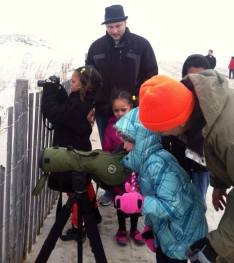
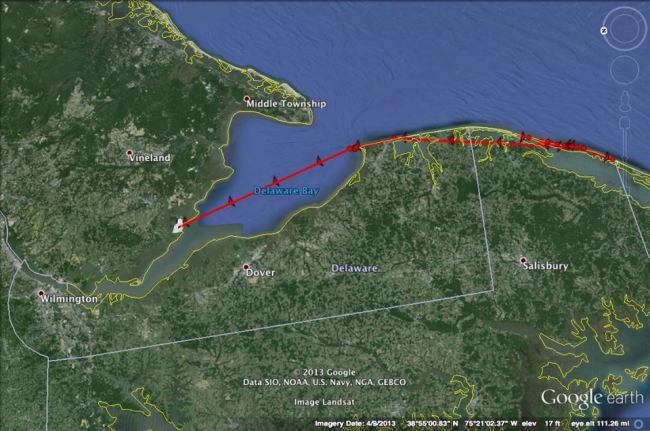
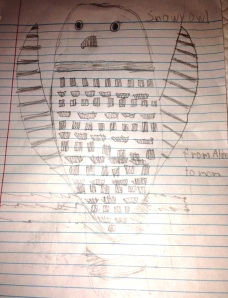
Project SNOWstorm UPDATE: Another snowy owl was banded & fitted with a transmitter on December 23rd in Wisconsin!
-Carrie
I’ve got some Snowys for you. Contact me through email.
Pingback: Project SNOWstorm | The Land Conservancy for Southern Chester County·